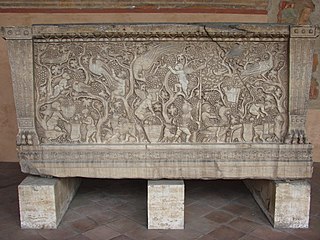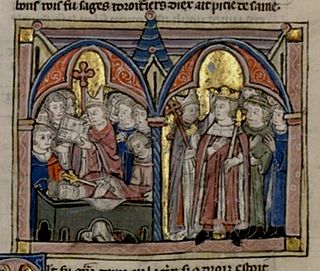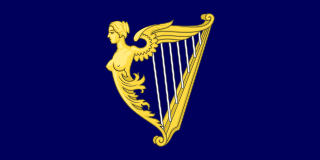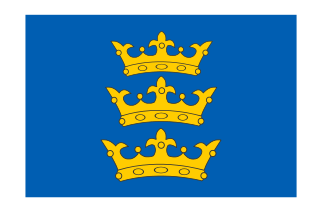| |||||
| Centuries: | |||||
|---|---|---|---|---|---|
| Decades: | |||||
| See also: | Other events of 1155 List of years in Ireland | ||||
Events from the year 1155 in Ireland.
| |||||
| Centuries: | |||||
|---|---|---|---|---|---|
| Decades: | |||||
| See also: | Other events of 1155 List of years in Ireland | ||||
Events from the year 1155 in Ireland.

Henry VIII was King of England from 22 April 1509 until his death in 1547. Henry is best known for his six marriages, and his efforts to have his first marriage annulled. His disagreement with Pope Clement VII about such an annulment led Henry to initiate the English Reformation, separating the Church of England from papal authority. He appointed himself Supreme Head of the Church of England and dissolved convents and monasteries, for which he was excommunicated by the pope.

Year in topic Year 1014 (MXIV) was a common year starting on Friday of the Julian calendar, the 1014th in topic the 1014th year of the Common Era (CE) and Anno Domini (AD) designations, the 14th year of the 2nd millennium, the 14th year of the 11th century, and the 5th year of the 1010s decade.

Year 1555 (MDLV) was a common year starting on Tuesday of the Julian calendar.

Year 1048 (MXLVIII) was a leap year starting on Friday of the Julian calendar.

Year 1174 (MCLXXIV) was a common year starting on Tuesday of the Julian calendar, the 1174th year of the Common Era (CE) and Anno Domini (AD) designations, the 174th year of the 2nd millennium, the 74th year of the 12th century, and the 5th year of the 1170s decade.

The Kingdom of Ireland was a monarchy on the island of Ireland that was a client state of England and then of Great Britain. It existed from 1542 until 1800. It was ruled by the King of Ireland, who were also the monarchs of England and then of Great Britain, and the kingdom was administered from Dublin Castle by a viceroy appointed by the English king: the Lord Deputy of Ireland. The Parliament of Ireland was composed of Anglo-Irish and native nobles. From 1661 until 1800, the administration controlled the Irish army. A Protestant state church, the Church of Ireland, was established. Although styled a kingdom, for most of its history it was, de facto, an English dependency. This status was enshrined in Poynings' Law and in the Declaratory Act of 1719.

The Lordship of Ireland, sometimes referred to retrospectively as Anglo-Norman Ireland, was the part of Ireland ruled by the King of England and controlled by loyal Anglo-Norman lords between 1177 and 1542. The lordship was created following the Anglo-Norman invasion of Ireland in 1169–1171. It was a papal fief, granted to the Plantagenet kings of England by the Holy See, via Laudabiliter. As the Lord of Ireland was also the King of England, he was represented locally by a governor, variously known as the Justiciar, Lieutenant, Lord Lieutenant or Lord Deputy.

The Crutched Friars were a Roman Catholic religious order in England and Ireland. Their name is derived from a staff they carried with them surmounted by a crucifix. There were several orders devoted to the Holy Cross, collectively known as Crosiers, that had some presence in England and there is much confusion to which specific order the friars belonged. Earlier literature linked most of the Crutched Friars to the Italian Crosiers, but later it was proven that they were a branch of the Belgian Canons Regular of the Order of the Holy Cross. The Crutched Friars were suppressed during the Dissolution of the Monasteries in 1538.

Laudabiliter was a bull issued in 1155 by Pope Adrian IV, the only Englishman to have served in that office. Existence of the bull has been disputed by scholars over the centuries; no copy is extant but scholars cite the many references to it as early as the 13th century to support the validity of its existence. The bull purports to grant the right to the Angevin King Henry II of England to invade and govern Ireland and to enforce the Gregorian Reforms on the semi-autonomous Christian Church in Ireland. Richard de Clare ("Strongbow") and the other leaders of the Norman invasion of Ireland claimed that Laudabiliter authorised the invasion. These Cambro-Norman knights were retained by Diarmuid MacMorrough, the deposed King of Leinster, as an ally in his fight with the High King of Ireland, Ruaidrí Ua Conchobair.
Events from the year 1739 in Ireland.
Events from the year 1659 in Ireland.
Events from the year 1399 in Ireland.
Events from the 1230s in England.
Events from the 1200s in England.
Events from the 1180s in England.
Events from the 1170s in England.
Events from the 1150s in England.
Events from the 1100s in England.
The Reformation in Ireland was a movement for the reform of religious life and institutions that was introduced into Ireland by the English administration at the behest of King Henry VIII of England. His desire for an annulment of his marriage was known as the King's Great Matter. Ultimately Pope Clement VII refused the petition; consequently, in order to give legal effect to his wishes, it became necessary for the King to assert his lordship over the Catholic Church in his realm. In passing the Acts of Supremacy in 1534, the English Parliament confirmed the King's supremacy over the Church in the Kingdom of England. This challenge to Papal supremacy resulted in a breach with the Catholic Church. By 1541, the Irish Parliament had agreed to the change in status of the country from that of a Lordship to that of Kingdom of Ireland.
Events from the year 1544 in Ireland.